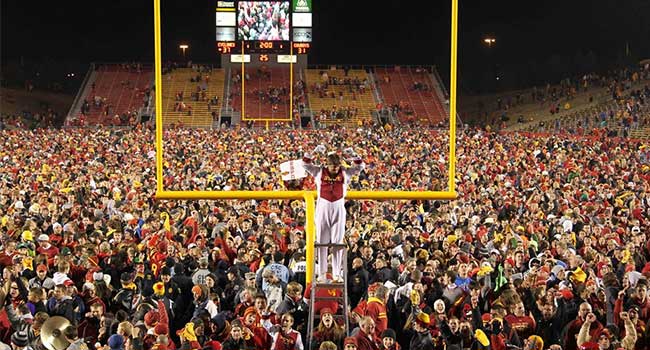
Iowa State to Appeal Big 12 Fine after Fans Rush Field
ISU was fined by the Big 12 after students and fans rushed the field after winning against WVU, making it unsafe for the apposing team to leave the field.
- By Sydny Shepard
- October 18, 2018
Sometimes you just get caught up in the game. That's what happened to students and fans of Iowa State University on Saturday when the Jayhawks upset the West Virginia University Mountaineers. Seconds after the game was won, students and fans rushed the field in celebration.
Due to the spontaneous celebration and the sheer amount of people flooding the field, the Big 12 said the university did not follow its pre-established, postgame celebration policy following the 30-14 win against the then No. 6 Mountaineers. ISU was fined $25,000.
Minutes after the Big 12 released the verdict, ISU announced it would appeal the decision.
According to the Big 12, the matter of rushing the field had an effect on West Virginia's ability to exit the stadium in a safe manner. The university said it reviewed the events of the night and determined law enforcement and security personnel took proper measures in making the situation safety, in some instances going beyond protocol.
"We have a duty to provide a safe game environment," Big 12 Conference commissioner Bob Bowlsby said in a release. "The Iowa State Department of Athletics has a written event management policy that was not thoroughly implemented, and was unsuccessful in ensuring the safety and security of all visiting team participants.
"Although the Big 12 Conference does not currently have a policy prohibiting spectators from entering playing areas for post-game celebrations, it is of the utmost importance that home game management provides adequate security measures for our student-athletes, coaches, game officials and spectators."
Iowa State University president, Dr. Wendy Wintersteen, announced on Tuesday that ISU would be appealing the decision, citing proper measures were taken postgame to ensure the safety of those involved.
"Our institution takes the safety and welfare of all student-athletes, officials, and fans very seriously. We have reviewed all of our procedures, including several videos of the post-game celebration, and we do not agree with Commissioner Bowlsby’s assessment of the events that evening,” Wintersteen said in a release. “Chief [Michael] Newton, of the Iowa State University Police Department, and the CSC staff had a very thorough and specific plan. Those plans were discussed and implemented prior to the game and were evaluated and adjusted during the game to ensure the safest atmosphere for every one attending the game, including the West Virginia players and staff.”
Image by Reese Strickland
About the Author
Sydny Shepard is the Executive Editor of Campus Security & Life Safety.